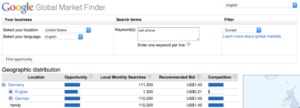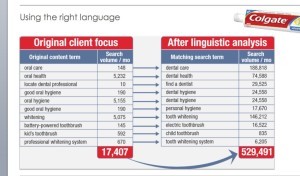Greater than 6 minutes, my friend!
Multilingual Digital Marketing and international SEO: the future trends of the localisation industry What is iSEO?
A few years ago a roof scratching bush turkey next door drove us nearly insane in the office. We contemplated all kinds of adventurous ways to get rid of him including throwing him onto the barbie, but as an Australian endemic animal he was protected, so I googled “remove annoying bush turkey” and dialled the number mentioned in Google’s first search result to contract Mick, the Bush Turkey Catcher. Problem solved. Mental sanity restored.
While recently in NYC for the GALA conference, I ran into SEO expert Chris Raulf. As you do in the City that never sleeps, Chris asked me over a Cosmopolitan Cocktail where to best hide a dead body… Whilst I deliberated an array of options from the obvious freezer to the Great Sandy Desert, Chris confirmed it’s simply page 2 of Google. Can’t be any safer than there. Nobody EVER looks there!
This is how important Search Engine Optimisation (SEO) has become for all of us who want to be found when people search for just that product or service you are offering. We simply need to be on page 1 of Google.
Now, as many of you are marketing internationally or towards multicultural and multilingual communities within your own country, you not only need to provide content in those target languages, but you also want to ensure that your content is actually found. What’s the use of going through the effort of localising (translating) your website if nobody visits it?
So I thought to share with you today a brief overview on International SEO and what you can do to increase your exposure in those global markets or multilingual communities you are targeting. International SEO is a growing trend in the translation industry and a good complement of a website translation project.
What is SEO, and why is International SEO (ISEO) different?
Search Engine Optimisation (SEO) is the process of optimising your website to rank higher on search engine results pages such as Google, Bing, Yahoo etc. If people search for your products or services, you want to show right on top. Just like the bush turkey catcher did. Same applies for your multilingual content. However, they might not search the same way they search in English, and even if you have a perfectly localised website, it might not be found by your target audience.
How and why are keywords such a vital part of how international SEO works?
You don’t want just hits, you want high quality organic search traffic to your localised website, meaning people who are looking exactly for what you are offering. Therefore you need to get into their heads and know how they search, so you can capture those keywords and optimise for them.
How can I research for keywords?
Using the Keyword Planner tool in Google AdWords, you identify keywords and sort and rank them based on the number of monthly search results, competition level and bid amount. You also want to see what words are currently driving traffic to your website using Google Search Console. Then you can compare the Google AdWords data to the Google Search Console data to identify which words you want to target based on the number of monthly searches, competition levels and high bids.
The Global Market Finder tool is useful to determine how other countries search and SEO experienced in country linguists can verify this. You can also check these keywords on social media, e.g. use Followerwonk for Twitter.
What about the keywords in other languages?
The keywords for your foreign language markets are not simply translations and the process is not the same. It requires linguists to research just how that culture is searching for your services. Whilst a mobile phone is “Mobiltelefon” in German, people actually use the word “Handy” to search for it.
Whilst “oral care” is the technical term, people search actually for “dental care”, and instead of “good oral hygiene” the search results for “personal hygiene” comprise oral health and are much higher. Cultural and linguistic habits come into play and influence the search and content consumption behaviour. Understanding search intent is the key to International SEO success.
Does everyone use Google?
On a global scale, Google is the most widely-used search engine, so you definitely want to get keyword data using Google tools; but keep in mind that outside Australia people use other search engines. For example, Yandex is the top search engine used in Russia, and Baidu is the top search engine in China. Make sure you’re using data from the appropriate search engines. Same with Social Media, whilst Facebook, LinkedIn and Twitter dominate in Australia, the Americas and large parts of Europe, there is QZone in China, V Kontakte in Kazakhstan, Belarus, Ukraine, Russia, Odnoklassniki in Kyrgyzstan and Facename in Iran.
What is a Multilingual Content Marketing Strategy?
Optimising your site with your new keywords is not enough. Only with the right pertinent multilingual content your pages will get ranked high in Google. Create a schedule where you will publish weekly or twice a month relevant and properly optimised blog posts, monthly press releases distributed by a press release distribution service, social media including Twitter and LinkedIn, as this enables Google to easier discover your content.
Why has the multilingual content to be better or at least as good as the source content?
Machine translation (MT) does nothing for SEO. A tourism website in Cairns used unedited MT for all of their localised webpages and “Cairns – the Gateway to the Great Barrier Reef” was translated in several European languages as “Pillars of stones – the start to the big wall of Reef”. Nobody in Europe searches for this when they are dreaming of diving in Tropical North QLD…
Do you have actual Content Creation & Optimisation Tips?
Check out some practical tips to ensure your website content is International SEO friendly:
- Meta tags:
- Title (50-60 characters: include main target ISEO keyword)
- Description (150-160 characters: include 1 or 2 target ISEO keywords)
- Keywords (2-4 target ISEO keywords)
- Alt text/Images
- Use keywords in the URL
- Blog posts: 350-500 words
- In-depth articles: 1,000+ words
- Press releases: 350-450 words
- One internal hyperlink per 100 words (include high quality external links to relevant websites)
- Add images and include alt tags with a target keyword
- Place keyword(s) in applicable H1, H2 & H3 heading format
- Use important keyword in first paragraph and variation of keyword in last paragraph and hyperlink to correct internal page
- Include Call to Action (share/click to request appointment or quote/contact us, etc.)
Site Structure for International SEO, and what about accents?
Your options are unique domain names (e.g. westernunion.fr), but this is also more expensive and more work. Country specific subdomains are easier to manage, like france.embassy.gov.au, or country specific sub-directories like Tourism Australia.
Don’t use special characters in URLs! Make sure to specify the language and country code of each page in the HTML’s head or submit a language version XML sitemap to Google. Avoid duplicate content issues of multiple versions/pages of the same language, as in Portuguese for Portugal and Portuguese for Brazil, by adding the “rel=canonical tag” to the page head.
Don’t use accents in meta data nor URL, but certainly on the main pages including the H1 Tags.
Why is analysing results regularly so important?
Unless you can measure it, you are just a person with an opinion. Therefore, just as you do with English keywords, you want to monitor your progress by tracking your multilingual keyword rankings using free tools such as Google Search Console or paid tools such as Moz. Monitor your Google organic search traffic in Google Analytics and you can see if your ISEO efforts are working.
Understanding search behaviour of other cultures and researching and transcreating the keywords is only one piece of the process of international and multilingual SEO – but enough to get you started.
And now I am sitting in my European office in Paris and the deafening sound of a jackhammer is delighting my afternoon. Oh, where’s Mick, my Bush Turkey Catcher? Or should I google “remove annoying construction worker”, or simply dispose of him myself and hide the dead body on page 2 of Google?







